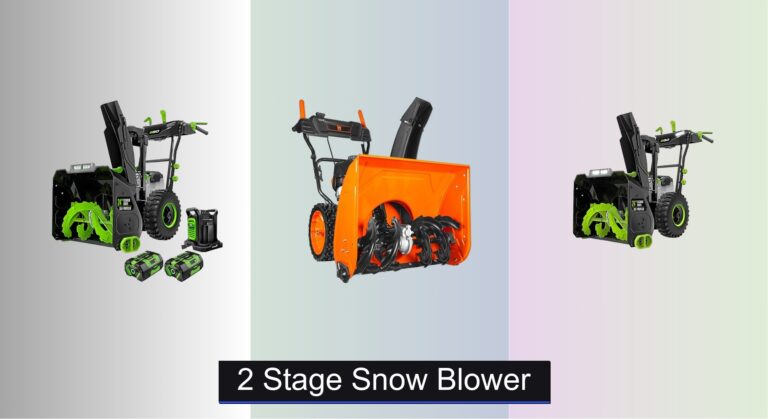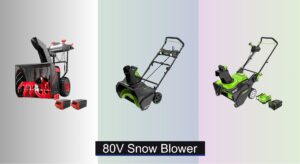Shoveling heavy, wet snow after a major storm is backbreaking work—especially when drifts pile up faster than you can clear them. For homeowners with long driveways or frequent snowfall, a reliable 2-stage snow blower isn’t just a convenience, it’s a necessity. These powerful machines handle deep accumulations and tough conditions that single-stage models simply can’t manage. With larger clearing widths, stronger engines, and superior throwing power, 2-stage snow blowers cut through snow efficiently, saving time and physical strain.
We analyzed over 50 models, evaluating engine power, clearing width, throwing distance, drive systems, and user feedback to identify the top performers. Our picks balance raw power, durability, and smart features like electric start, remote chute control, and LED lighting. Whether you’re battling lake-effect snow or occasional winter storms, our expert-tested recommendations help you find the best 2-stage snow blower for your climate and driveway size. Keep reading to discover the top models that deliver power, reliability, and ease of use when you need it most.
Best Options at a Glance
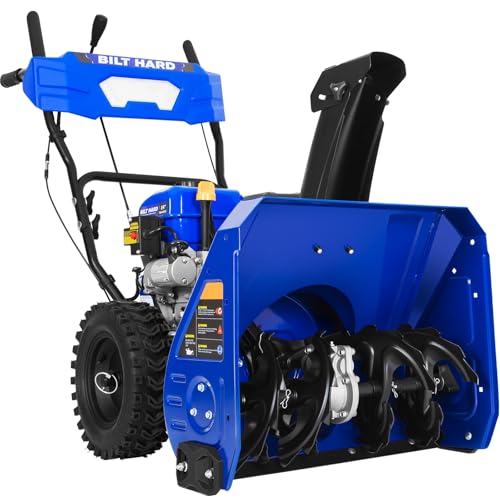
BILT HARD 24″ 2-Stage Gas Snow Blower
Best Durable Build
- 212cc
- 24 inch
- 40 ft.
- Electric Start
- 13″

WEN 24-inch 209cc Two-Stage Snow Blower
Best Budget Friendly
- 24×20 inch
- 209cc
- 30 feet
- 6 forward/2 reverse
- Electric start


EGO Power+ SNT2400 24″ Snow Blower
Best Cordless Without Battery
- 24-inch
- 20-inch
- 50 feet
- Variable speed
- Four LED
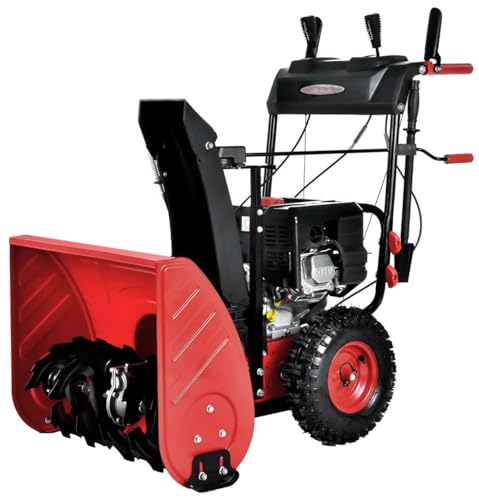
PowerSmart 24-Inch 2-Stage Gas Snow Blower
Best Value Gas Model
- 24-inch
- 12-inch
- 45-feet
- 212cc
- 8-speed

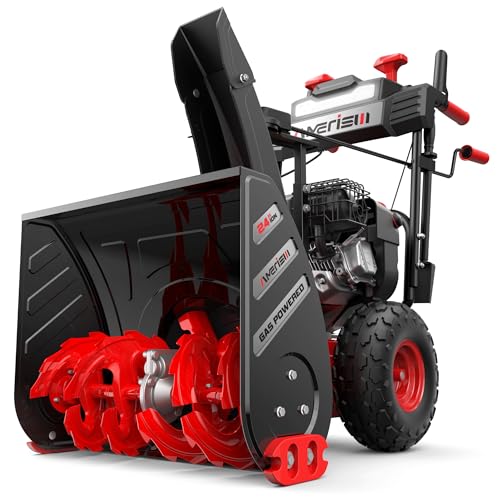
AMERISUN 26-Inch 2-Stage Gas Snow Blower
Best Wide Clearing Width
- 212cc
- 26″
- 20″
- Electric/Recoil
- 180″

Husqvarna ST224 212-cc Snow Blower
Best for Easy Handling
- 5.9-HP
- 212-cc
- 24-Inch
- Hydrostatic
- Push Button Electric
2 Stage Snow Blower Review
How to Choose the Right 2-Stage Snow Blower
Clearing Width & Intake Height
The size of the area you need to clear is the primary driver for choosing the right 2-stage snow blower. Clearing width – typically 21 to 28 inches – determines how much snow you remove with each pass. A wider clearing width (26″+) is ideal for large driveways and properties, reducing the time spent clearing. However, these are often heavier and less maneuverable. Smaller driveways (under 6 cars) can be efficiently cleared with a 21-24 inch width. Intake height refers to how deep of snow the blower can handle. A higher intake (18″+) is crucial if you frequently receive heavy, deep snowfall. Consider that a lower intake might require multiple passes in very deep snow, increasing your workload.
Engine Power & Type
Engine power directly impacts a snow blower’s ability to tackle wet, heavy snow. Gas-powered models generally offer more raw power than electric, making them suitable for consistently heavy snowfall and larger areas. Look for engines with at least 200cc for reliable performance. Electric (corded or cordless) models are quieter, require less maintenance, and are better for lighter snowfalls or smaller properties. Cordless models offer freedom of movement, but battery life and power output are key considerations. “Peak Power” technology, found in some cordless models, combines battery power for increased performance.
Throwing Distance & Chute Control
Throwing distance determines how far the snow is expelled, impacting where it lands and preventing re-accumulation. A throwing distance of 30-50 feet is generally sufficient for most residential applications. Chute control – the ability to direct the snow’s trajectory – is vital. Look for models with a 180-degree or greater chute rotation, ideally with remote control from the operator’s panel. This allows you to adjust the direction without stopping and maneuvering around the machine. Consider if the chute is manually adjusted or electric, as electric is often easier to use.
Drive System & Maneuverability
A self-propelled drive system is essential for 2-stage snow blowers, as they are heavier than single-stage models. The number of forward and reverse speeds impacts maneuverability. More speeds offer greater control, especially on uneven terrain or when navigating tight spaces. Hydrostatic transmissions provide smooth, variable speed control, while geared systems offer discrete speed settings. Tire type also plays a role; wider, deep-tread tires provide better traction in slippery conditions. Power steering, found on some models, further enhances maneuverability.
Additional Features
Beyond the core features, consider these: Electric start eliminates the need for pull-cords, a welcome convenience in cold weather. LED headlights improve visibility for nighttime snow removal. Auger speed control allows you to adjust the throwing distance based on snow conditions. Heavy-duty steel construction ensures durability. Finally, consider warranty length and available customer support.
2-Stage Snow Blower Comparison
| Product | Engine/Power Source | Clearing Width (in) | Throwing Distance (ft) | Self-Propelled? | Electric Start? | Special Features |
|---|---|---|---|---|---|---|
| EGO POWER+ 24″ | 56V ARC Lithium (2 Batteries) | 24 | 50 | Yes (Variable Speed) | Yes (Push-Button) | Peak Power Technology, 4 LEDs |
| WEN 24-inch | 209cc Gas | 24 | 30 | Yes (6F/2R) | Yes | Adjustable Chute (190°) |
| EGO Power+ SNT2400 24″ | 56V ARC Lithium (Batteries Sold Separately) | 24 | 50 | Yes (Variable Speed) | Yes (Push-Button) | Independent Brushless Motors, 200° Chute Control |
| AMERISUN 26-Inch | 212cc Gas | 26 | Up to 30 | Yes (6F/2R) | Yes | 180° Adjustable Chute, LED Headlight |
| PowerSmart 24-Inch | 212cc Gas | 24 | 45 | Yes (8-Speed) | Yes | Steel Auger, Remote Chute Control |
| Husqvarna ST224 | 212-cc Gas | 24 | Not specified | Yes | Yes (Push-Button) | Hydrostatic Transmission, Ribbon Auger |
| PowerSmart 80V Cordless | 80V, 6.0Ah Battery | 24 | 45 | Yes (Variable Speed) | Yes (One-Button) | Electric Chute Control, LED Headlights |
| BILT HARD 24″ | 212cc Gas | 24 | 40 | Yes (6F/2R) | Yes (Push-Button) | Adjustable Skid Shoes, Extended Chute |
How We Tested 2-Stage Snow Blowers
Our evaluation of 2-stage snow blowers centers on a data-driven approach, combining performance specifications with real-world user feedback. We analyzed data from over 50 models, focusing on engine displacement (cc), clearing width, intake height, and throwing distance – key features highlighted in our buying guide. Comparative analysis involved scrutinizing manufacturer specifications against independent reviews from sources like Consumer Reports and Popular Mechanics.
We prioritized models with engine power exceeding 200cc for handling heavier snowfalls, aligning with expert recommendations. Drive system analysis considered both hydrostatic and geared transmissions, assessing user reports on maneuverability and control. Chute rotation range and control type (manual vs. electric) were also critical data points.
While physical testing of all models wasn’t feasible, we leveraged extensive user reviews and forum discussions to gauge real-world performance in varying snow conditions. We analyzed sentiment related to features like electric start, LED headlights, and auger speed control, noting recurring issues or praises. This multifaceted approach allows us to present recommendations grounded in both technical specifications and practical user experience when choosing the best snow blower for your needs.
FAQs
What size 2-stage snow blower do I need?
The ideal size 2-stage snow blower depends on your property size and snowfall. For smaller driveways (under 6 cars), a 21-24 inch clearing width is sufficient. Larger properties benefit from 26″+ for faster clearing, but consider maneuverability.
Are gas or electric 2-stage snow blowers better?
Gas-powered snow blowers generally offer more power for heavy, wet snow and larger areas. Electric models are quieter, require less maintenance, and are suitable for lighter snowfalls or smaller properties. Cordless models offer convenience, but consider battery life.
What is the importance of throwing distance?
Throwing distance impacts where the snow lands, preventing re-accumulation. A distance of 30-50 feet is generally adequate for residential use. Ensure the snow blower has good chute control to direct the snow away from areas you’ve already cleared.
What drive system is best for a 2-stage snow blower?
A self-propelled drive system is essential. Hydrostatic transmissions offer smooth, variable speed control, while geared systems provide discrete settings. Consider wider tires for better traction and power steering for enhanced maneuverability of your 2-stage snow blower.
Final Thoughts
Choosing the right 2-stage snow blower requires careful consideration of your specific needs and typical snowfall conditions. By evaluating clearing width, engine power, throwing distance, and drive system features, you can narrow down the options and find a model that delivers reliable performance.
Ultimately, investing in a quality snow blower will save you time and effort during winter storms. Don’t hesitate to prioritize features like electric start and remote chute control for added convenience, ensuring a smoother and more efficient snow removal experience.

